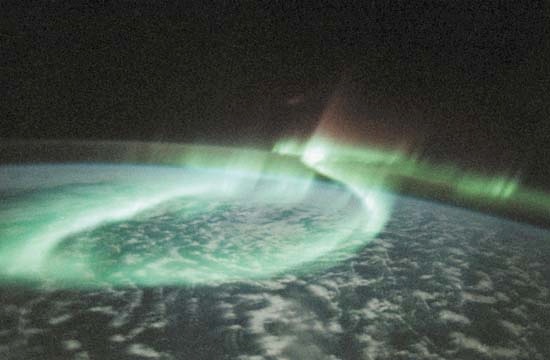aurora
atmospheric phenomenon
 luminous phenomenon of Earth's upper atmosphere that occurs primarily in high latitudes of both hemispheres; auroras in the Northern Hemisphere are called aurora borealis, or northern lights; in the Southern Hemisphere, aurora australis, or southern lights.
luminous phenomenon of Earth's upper atmosphere that occurs primarily in high latitudes of both hemispheres; auroras in the Northern Hemisphere are called aurora borealis, or northern lights; in the Southern Hemisphere, aurora australis, or southern lights.A brief treatment of auroras follows. For full treatment, see ionosphere and magnetosphere.
Auroras are caused by the interaction of energetic particles ( electrons and protons) from outside the atmosphere with atoms of the upper atmosphere. Such interaction occurs in zones surrounding Earth's magnetic poles. During periods of intense solar activity, auroras occasionally extend to the middle latitudes; for example, the aurora borealis has been seen as far south as 40° latitude in the United States.
Auroras take many forms, including luminous curtains, arcs, bands, and patches. The uniform arc is the most stable form of aurora, sometimes persisting for hours without noticeable variation. However, in a great display other forms appear, commonly undergoing dramatic variation. The lower edges of the arcs and folds are usually much more sharply defined than the upper parts. Greenish rays may cover most of the sky poleward of the magnetic zenith, ending in an arc that is usually folded and sometimes edged with a lower red border that may ripple like drapery. The display ends with a poleward retreat of the auroral forms, the rays gradually degenerating into diffuse areas of white light.
Auroras receive their energy from charged particles traveling between the Sun and Earth along bundled, ropelike magnetic fields. The particles are driven by the solar wind, captured by Earth's magnetic field (see geomagnetic field), and conducted downward toward the magnetic poles. They collide with oxygen and nitrogen atoms, knocking away electrons to leave ions in excited states. These ions emit radiation at various wavelengths, creating the characteristic colours (red or greenish blue) of the aurora.
In addition to Earth, other planets in the solar system that have atmospheres and substantial magnetic fields—i.e., Jupiter, Saturn, Uranus, and Neptune—display auroral activity on a large scale. Auroras also have been observed on Jupiter's moon Io, where they are produced by the interaction of Io's atmosphere with Jupiter's powerful magnetic field.
- bone cancer
- bone china
- bone conduction
- bone cyst
- bone disease
- bonefish
- bone formation
- Bone, Henry
- bone marrow
- bone marrow aspiration
- bone marrow transplant
- bone remodeling
- Boner, Ulrich
- boneset
- Bone, Sir Muirhead
- Bonestell, Chesley
- Bonet, Juan Pablo
- Bonfils, Frederick Gilmer
- Bonfini, Antonio
- Bongars, Jacques, Seigneur De Bauldry Et De La Chesnaye
- Bongo
- bongo
- bongo drums
- Bongor
- Bong Range